To diagnose (that is, the definitions of minerals are allocated to special groups, for example:
- use as raw materials for enterprises
- facing material
- stones for different crafts,
- stones for jewelry and so on.
Most often use the principles of classification, which are based on the laws of the structure of minerals - this chemical composition, features of the structure of the mineral, texture etc., that is, external signs. Exterior signs - landmarks that give the opportunity to a lover do not get lost in the world of stones. To be able to determine the stones is important for lovers of jewelry, so as not to be mistaken and able to recognize natural stones.
For an amateur without special equipment first and, probably, the only reception of the definition of the stone is a visual inspection. Inspecting, it is necessary to identify and formulate the properties of an unknown mineral, its shine, color, shades, hardness, shape, ability to split, transparency and other features.
Crystals and other forms of minerals
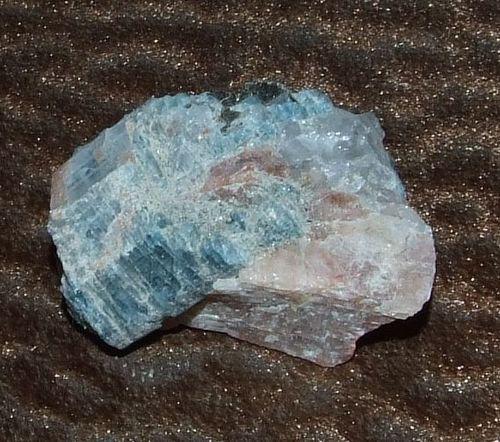
Apatite. Apatite is the main raw material for the phosphate fertilizer industry.
Most minerals are found in crystalline state.
Usually crystals have only inherent in the form. Galita cubes, rutila needles, calcite rhombohedra, etc. Minerals can be and in non-crystalline, amorphous form, for example, opal, chalcedony, gagat.
Pronounced, individual crystals are quite rare. Usually find them accumulations - aggregates.
Crystal aggregates are different - grainy, dense, needle, prismatic. For minoric crystal (and not only it) are characterized by dresses - crystals, attached as in the brush, one end to the base.
Nerbonic copper and manganese oxides in various breeds and minerals may be in the form of dentrit (dendrites) - branched, tree aggregates. Some units, such as amethyst - purple quartz - is often found in the form of concrete or coaspery - cavities or voids filled with mineral substance.
In the same crystals grow from the outskirts to the center, and in nodules - From the center to the periphery.
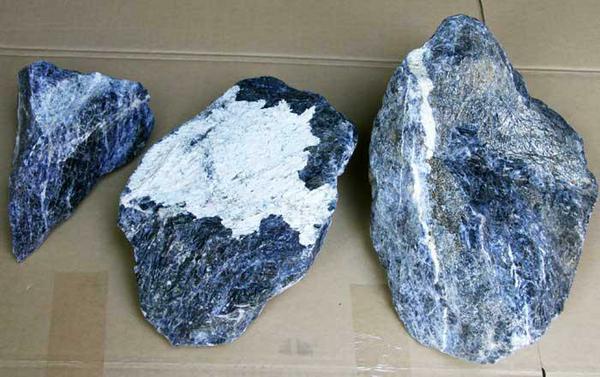
Minerals can meet and in the form of film raids
, olith, which are similar to the slipped balls.
The form in which one or another mineral is found is one of its distinctive features. Therefore, collectors often prefer to collect non-treated stones, and their natural forms - here minerals are very individual and are very different from each other.
Some physical properties of minerals, such as density or magnitude, are sustained.
Other properties for the same mineral may vary depending on the quality of the surface (its processing): shine, or disguised with a microcrystalline structure as spine. Third properties, for example, color, are characteristic of for some minerals, and others are very much changed from one sample to another. For proper visual diagnostics, it is necessary not only to know the external signs of minerals, but also to represent the role of each sign in diagnostics - sometimes the color is secondary, sometimes it is more important, etc.
At first, it is enough to be able to recognize the external signs of minerals - the shape, symmetry of crystals, the characteristic type of aggregates and individuals, color, hardness, shine, etc.
Shine
Gloss is a qualitative characteristic of the light reflection of the mineral surface - an important feature of minerals. Distinguish: 
- the glitter metal, in which the surface of the mineral glitters, as if the metal (minerals of the group of native elements, as well as most grainy compounds and some oxides);
- approaching metal - metalloid, as, for example, graphite;
- diamond shine - not only diamond, but also some other minerals; Examples of minerals with diamond glitter are kinovar, sulfur, cassiteritis and others;
- glass glitter (quartz, calcite, and many other minerals);
- pearl - Talc and some species of mica;
- fat when the surface of the mineral is like oily (native sulfur or quartz);
- shell gloss - minerals with a fibrous structure - asbestos, fibrous plaster, as well as glass and diamond shine.
More than half of minerals on the edges and breaks of crystals Possess glass glitter: calcite, topaz, amphibole, pyroxes and others. 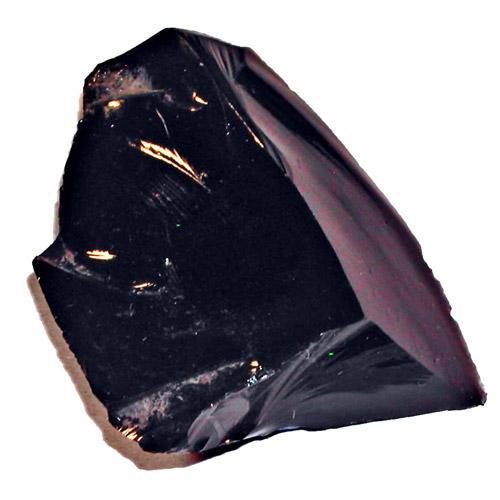
The degrees and gloss types are conditionally raised, in fact there are no sharp transitions between them. The block structure of the crystal, microclastic, inclusion, corrosion and weathering of the surface, film, flakes of foreign minerals - all this reduces the shine and sometimes makes this sign unreliable, cannot be used as the only one. Moreover, in fine-crystalline units, the eye perceives the overall picture, and not separate individuals, so the gloss of the mineral can be different than in large crystals. The well-educated gypsum crystals have a glass shine, and parallel-fibrous variety of gypsum selenites - silky. Potted or pressure, plaster crystals acquire pearl shine.
Mineral varieties may also differ glitter. So, Andrait, like other grenades, has a glass shine, but the Demanto is approaching the diamond.
To estimate the brilliance, consider the clean and dry surface of the stone.
Mineral color
The color, the color of minerals is very and very diverse. They depend on the chemical composition, the inclusions of other substances, the features of the structure of the mineral and are the most important diagnostic sign. But it happens so (and quite often) that the same type of color may vary in very wide limits. Some minerals change color in a fragmented, exterior state. For example, pyrite in separate crystals of brass yellow color, and in the powder - black. For this property, it is easily recognizable. 
Coloring can be inherent in the substance of the mineral itself, that is, due to the presence of the mineral of the so-called chromophores - chemical elements of chromium, manganese, iron, cobalt, nickel, copper, titanium. Such color is called idiocomatic. But the color can also be due to some defects of crystalline structures, "irisions" - inhomogeneous refraction and reflection of light due to the plastic inhomogeneity of the crystal.
Many minerals received their name in their characteristic color. For example, Albit - White Translated, Auripigment - Golden Color, Hematite - Bloody, Celegen - Heavenly Blue, Tsitrine - Yellow, etc. From the same Persian root, meaning the word "blue", the names of three blue Minerals - azurita, Lazurita, Nazulita. But in most part flower names exist in Greek and Latin languages.
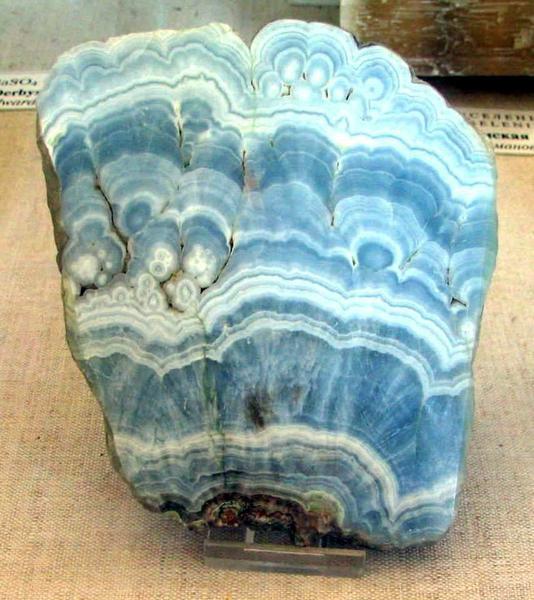
Celegen.
Permanent (not varied by different conditions) The mineral color is of paramount importance. The sulfur is always yellow, Azurites - always blue, malachite - green, rhodotrozit - pink, etc.
And at the same time, the color of the stone can change. This may occur from different conditions due to the presence of impurities.
For example, calcite can be painted with impurities in blue, lilac, yellow and other colors. Chromium impurities are obliged to their color Red Ruby and Pill, Green Island and Uvarovit. Chrome-containing Alexandrite and Kermerseraite have a green color with sunlight, and with electric - purple.
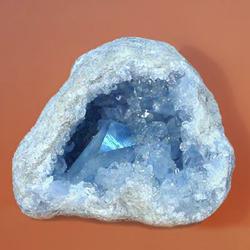
Celegen.
The widespread in the earth's crust of iron and chromium explains the reason for the propagation of brown, red and green shades in minerals. In contrast to this blue minerals exists relatively very little.
In the color of the mineral, the main colors, idiocomatic, inhomogeneous coloring can serve as additional diagnostic signs.
The color of the mineral must be determined in the fresh, clean surface of the face or break, when it does not disguise, oxides, weathered, films.
Singleness is a specific lighting game or another additional effect, and sometimes the iridescent coloring of the surface peculiar to minerals with a metal glitter. Some chalacedones have a bright blue color, due to the scattering of light in the microporous surface layer. When moisturizing the color disappears, and when drying, appears again.
The color feature is very important in determining minerals. The trait, left on the matte, unlawed surface of the porcelain, consists of a thin mineral powder. The color of the feature is not as saturated, the yaps and rich in shades as the color of the crystals, but this is a more permanent sign, which is used in determining the opaque thick-painted minerals, which are difficult to determine.
Low-cooled minerals usually give the same white feature.
In color of crystals and color, it is possible to sometimes establish the presence of chemical impurities and the place of mineral in isomorphic row. The color and feature of dark minerals should be considered in bright lighting.
Mineral hardness
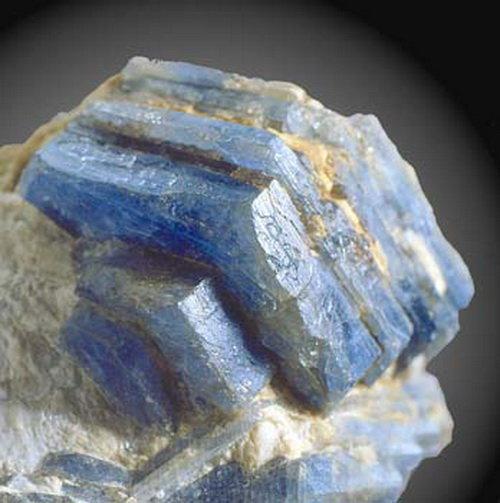
The ability of one mineral to leave scratch on the surface of another depends on its hardness. The hardness characterizes the resistance of the mineral to the destructive mechanical effect on its surface. Hardness is of great importance for stones used in decorations - so that they do not destroy quickly when sock. This resistance is due to the structure of the crystal and the strength of chemical ties. The hardness is reduced during defects and the inhomogeneous structure of the stone.
The sequence number or coefficient is defined as follows: if any mineral scratches, for example, calcite having a hardness 3, then its hardness is indicated by the coefficient of 3.5 (or 3-4).






